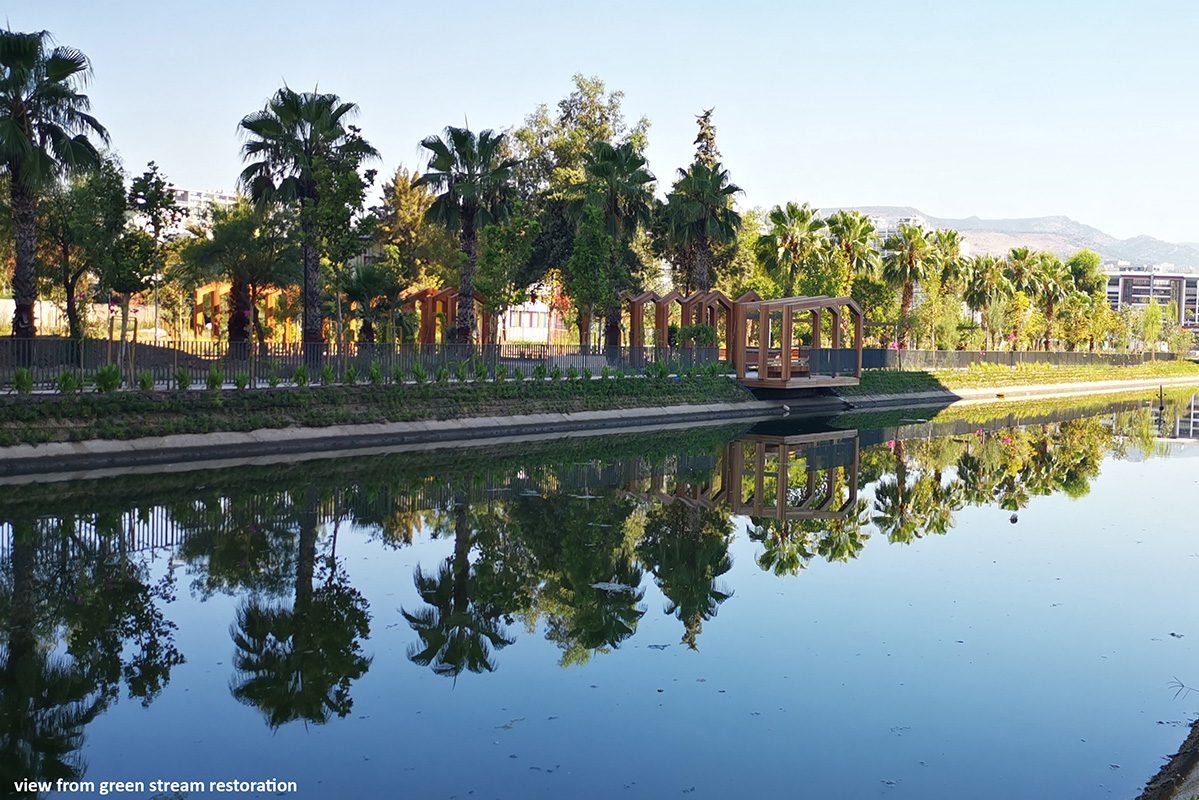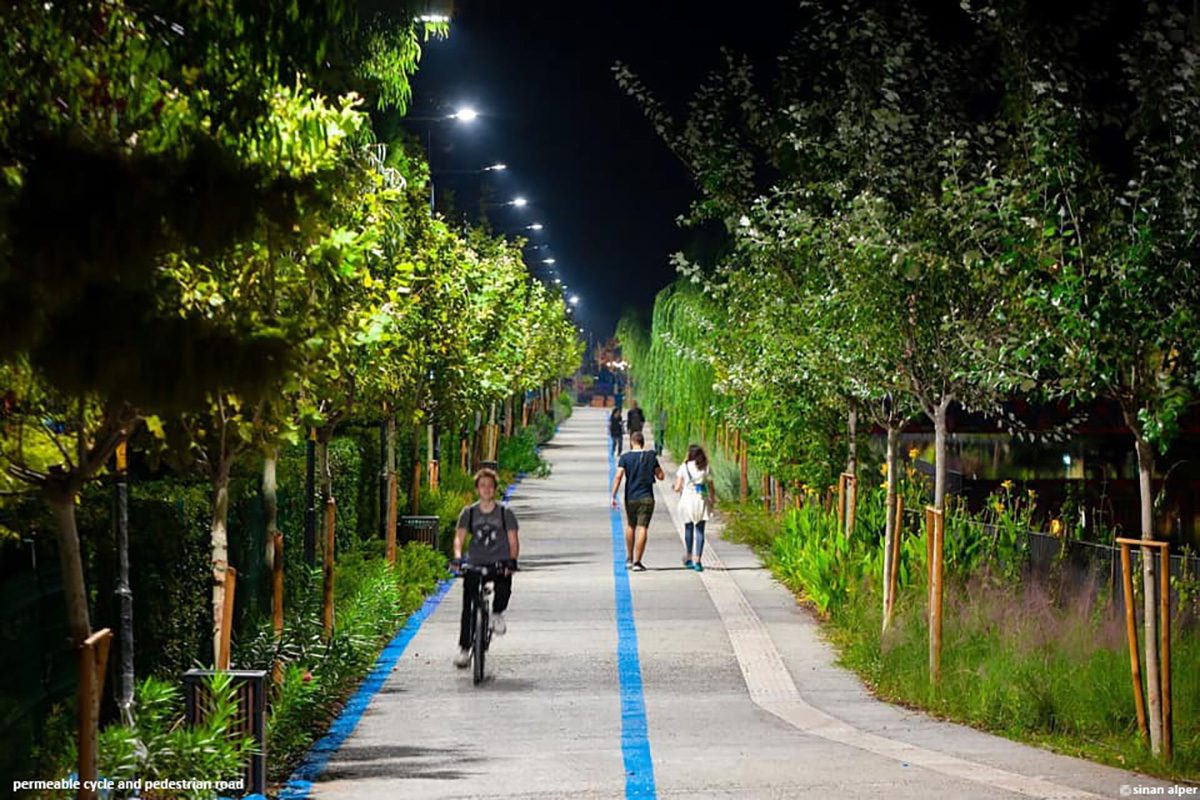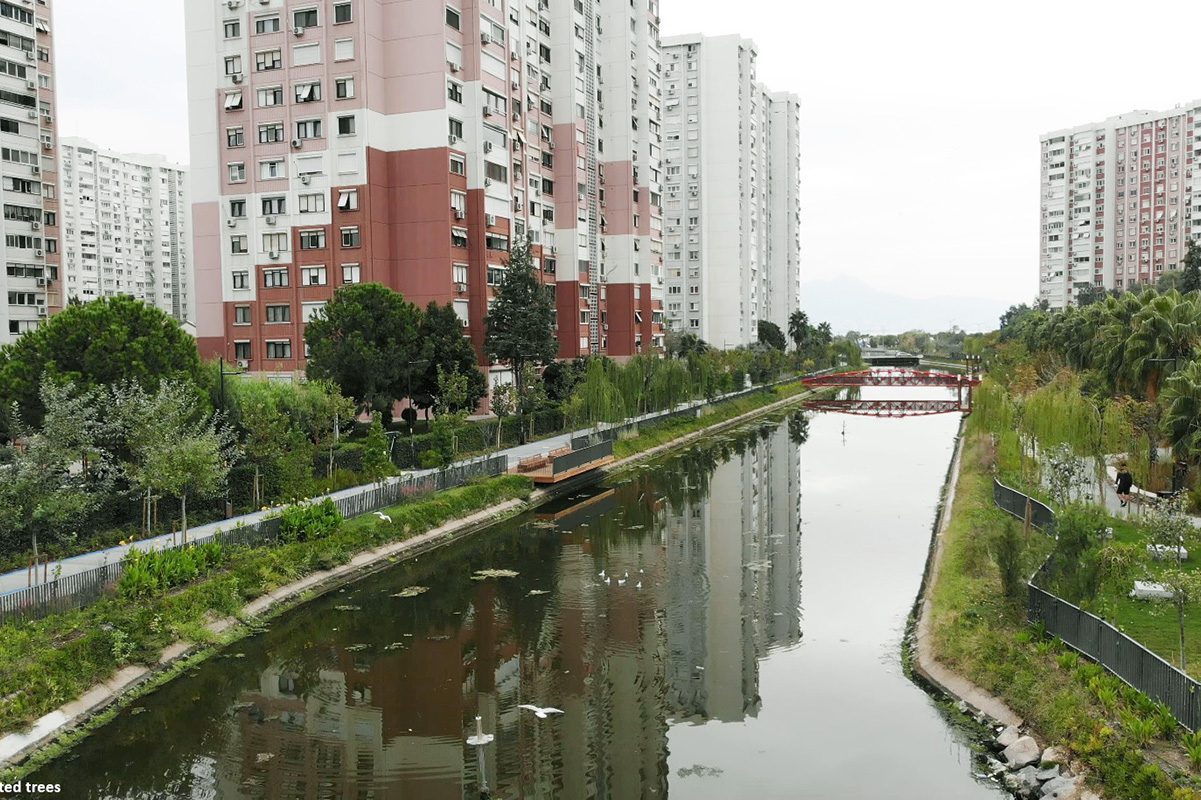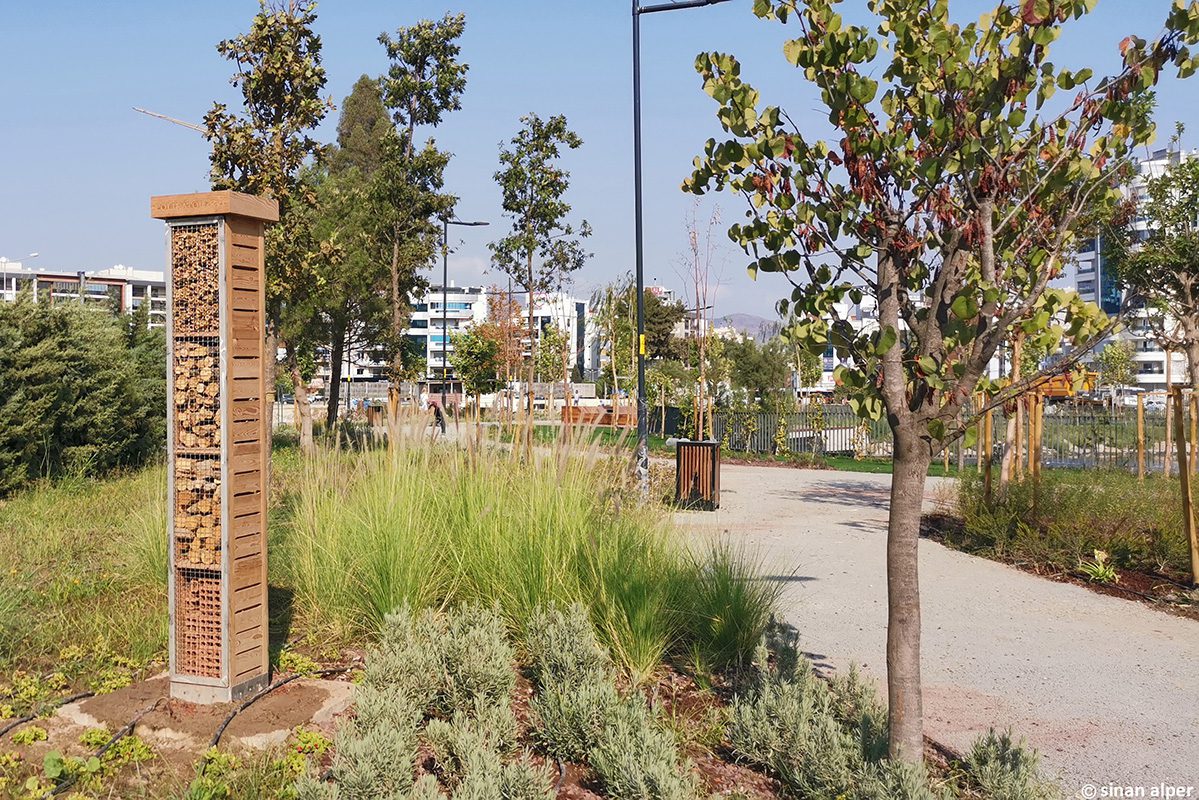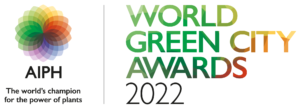Addressing the urban challenge
Breadth of the issue – How are the problem(s) that are being tackled by your initiative affecting citizens/local businesses or a significant component of the local wildlife?
The project aims to achieve a variety of impacts related to both environmental and socio-economic aspects. By doing so, it will improve life quality in urban areas, raise awareness on the importance of environment preservation among citizens, generate new green market opportunities for SMEs at the national and international levels. Moreover, the project offers great value to the city in terms of environment via implementations of NBSs, and economy, through sustainable development and training. All these issues via NBSs make the project as part of the Living Park Project of Izmir which are the large-scale green areas located in rural and natural zones targeted for conservation on the outskirts of the city and connected to the city center by İzMiras Routes. The living Parks bring together three types of functions normally treated as separate: ecological conservation, agricultural production, and recreational usage. The Living Parks are a peri-urban park model where the potential contained in a holistic urban/rural, and natural/cultural structure is expressed and experienced. In these spaces, the functions of meeting the recreational needs of residents and tourists, supporting ancient agricultural production methods and the branding of local products, and raising awareness and promoting the conservation of local flora and fauna, are all fulfilled. While visitors are enjoying recreational activities in the rural areas on the outskirts of the city, they will also be able to discover ways of experiencing nature and traditional agricultural practices.
Depth of the issue – How seriously are the problems being tackled by your initiative impacting the life of the citizens/businesses/wildlife concerned?
NBSs are interventions inspired by nature and are designed to address social and environmental problems. The idea behind these solutions is to better the use of properties of plants, soils and other natural elements to design cities and to increase the sustainability of lifestyle. Examples of challenges, which will be tackled with NBSs are climate change, air and water pollution, floods and rising temperature. The NBSs in the project provide solutions to four main problems: These problems are loss of biodiversity, heatwaves and temperature increases, floods (Fluvial floods), and the height of CO2 levels and pollutants in the atmosphere. The available green space has been expanded and therefore the tree crown cover and permeable surfaces have been greatly increased. In addition, a long and wide green-blue corridor extending from the sea inwards carries the refreshing wind to the interior. These actions are aimed at reducing the urban heat island effect and the risks posed by heatwaves. In addition, the intensive use of pollinator-friendly plants in the area and the construction of pollinator houses are an action against the growing loss of urban biodiversity. The increased amount of permeable surface around the stream is also an adaptation measure against possible flood risk.
The power of plants and natural ecosystems to deliver benefits
How is the initiative shaped by scientific evidence of the potential for plants and natural ecosystems to deliver benefits?
Based on a review of existing scientific literature, policies, and the information collected throughout the UrbanGreenUP project, a methodology for the assessment of the replication potential of NBSs was created. This methodology will be a heuristic aimed at guiding other cities and any other in creating its own model. It will be publicly available as a report along with the analysis of the replication potential in follower cities. One of the most important conditions for the applicability of the project is to measure the performance of the solutions brought by the application in the monitoring process and to interpret the results by taking into account the baseline values. In addition, measuring this area permanent in the long term and making its maintenance and management sustainable will also guide and ease the applicability of projects in different regions with this context. Similarly, the extent to which the public and the local government have adopted these practices and policy changes over time and the extent to which the local government has included these novel implementations in the planning and design processes of the venue is another important issue. Although local resources were sufficient to do such a project, international resources (for example, Peynircioglu is an EU project) and cooperation were very important in spreading such practices and increasing their visibility.
How has the city exploited the potential of plants and associated ecosystems to deliver more than one benefit?
In terms of solving ongoing and potential problems in the area, plants have multifunctional and crucial roles that the project team have been aware of carbon footprint reduction, air circulation, preventing floods and their negative effects, removing pollution from both air and water and decreasing the effect of heat island. In addition to plant usage, the project includes solutions that cover a variety of complementary yet interconnected aspects of urban life and infrastructures.
With NBSs that are implemented in Peynircioglu Stream Ecological Restoration Project, it is aimed to: having greater carbon sequestration and reduction of air pollution (the aim of this measure is to retain and store atmospheric carbon by increasing the number of trees, tree crown cover and permeable surfaces), providing a range of benefits such as mixing rainwater into groundwater, microclimate regulation through shading and evaporation, food supply for biodiversity and recreation services, creating new green fields, increasing the water holding capacity of the soil, increasing the use of natural vegetation, increasing biodiversity, increasing public use of river banks, reducing Urban Heat Island Effect and creating a more permeable surface in terms of Flood Control and sustainable urban drainage systems. In the name of flood prevention, 1.6 km of stream bed restoration was carried out based on technical and engineering solutions. Within the scope of these objectives, permeable bicycle and pedestrian paths, green and permeable stream surface, green pavement applications, green fences, fruit walls and pollinator houses are implemented.
Innovative and Collaborative Solution
How does the initiative show evidence of feasibility, including on-going financial and logistical support?
Studies carried out within Peynircioglu Ecological Restoration Project in Mavisehir district were realized as a result of the cooperation of the Izmir Metropolitan Municipality with both its budget and cofinancing of the European Union under the HORIZON 2020 framework. In addition, the use of local, low-water-consuming plants and the use of drip irrigation systems ensured a feasibly efficient process of the Project.
In what ways is the initiative innovative?
NBSs which are delivered in this project are nature-inspired interventions, designed to deal with social and environmental problems. The idea behind these solutions is to design cities that are coherent with their environment, in parallel with native plants, soils and other natural elements and support the natural cycle of life. Examples of challenges to be addressed with NBSs include climate change, air and water pollution, floods and rising temperatures.
The project takes into account its environment and future conditions and seeks solutions to possible and existing problems. It offers natural, simple, lean solutions (such as permeable pavement application and İzMiras Routes) in which it proposes new methods in design. The success of the project is directly related to the fact that it sheds light on the problems of the future and creates sustainable solutions as well as offering new opportunities to the locals. The vision of the project is also covering the vision of IMM’s Izmir’s Strategy for Living in Harmony with Nature. This vision claims synthesis of culture and nature while aiming for innovation in methodology such as NBSs. In addition, the fact that the project is supported by the EU’s H2020 UrbangreenUP Project aiming Renaturing Urban Planning (RUPs).
How is the initiative supported by collaborative working across disciplines and sectors?
The design, completed with a holistic approach, also includes co-financing from the IMM. Within the scope of H2020 UrbangreenUP, the local project partners are universities (Izmir Institute of Technology and Ege University) and SMEs (Demir Energy, and Bitnet). In this context, many different professionals had the opportunity to collaborate. For example, environmental engineers, mechanical engineers, landscape architects, computer engineers, architects, civil engineers, electrical engineers, agricultural engineers and city planners had the opportunity to work together on the project. In addition, professors from different departments from universities have conducted extensive measurement studies on monitoring and dissemination activities.
How does the initiative demonstrate evidence of community support?
During the pre-implementation phase of the project, it was organised a design workshop, within the context of NBSs with different design institutions and associations. Approximately 70 design students and workshop coordinators attended the co-design of NBSs organized by IMM at Fablab İzmir. The pollinator house, which was one of the outcomes of this workshop, has been implemented in the project area. In addition, during the implementation of the project, the contributions of the people living in the vicinity were integrated into the project during the implementation processes in which the neighborhood managers participated.
Implementation, Impact and Replicability
How does the initiative demonstrate evidence of a track record of success against pursued objectives?
Intensive use of pollinator-attracting plants in the redeveloped and expanded green area in and around Peynircioglu Stream and the effect of pollinator houses are observed and measured during the monitoring process, which was carried out for two years. After recording before-after baseline values during the two-year monitoring process, within the newly planted plants and the increased green space, a high increase in the number of birds and pollinators, which had never been observed in the area before. Similarly, trees in the green area whose baseline values are measured before application measure the number of pollutants and carbon, they hold with measurements that were repeated for two years. Again, in the measurements of the monitoring process of plantation of new trees, a significant decrease in the amount of carbon and the heat island effect was detected. Very high values were also detected in the permeability tests carried out in the project area. In the flood disaster in the same region in 2020, while houses and cars were flooded in the immediate vicinity, it was determined that there was no puddle in the area.
How has the initiative had a ripple effect beyond the scope of the initiative itself, thereby demonstrating a change in the city’s and/or its partners’ way of working with plants?
The project has formed the basis for many practices and strategies with NBSs. The plants applied in the project were included in the “Natural Green Project” to be applied throughout the city. Natural Green Project is in order for the city to regain its natural vegetation cover in its parks, local plant species will be used in inner-city practices. The aim is to propagate an approach to landscaping throughout the city that utilizes plants with reduced water consumption requirements and are highly adaptable. In addition, the permeability capacity and green infrastructure of the project were evaluated within the scope of the “Sponge City Program” which aims to increase permeability capacity of rainwater in heavily urbanized areas. The project also pioneered the “Izmir’s Strategy for Living in Harmony with Nature”. With this strategy, Izmir has characterized its essential strategy for combating the climate crisis and becoming a city in harmony with nature as “creating partnerships regarding physical, economic, and cultural plans for the administration of urban and rural areas”. Rather than referring to the urban landscape and rural landscape as two separate parts, this will bring nature and culture together, uniting them within the flow of life.
How have other cities expressed interest in the initiative, or what potential does it have to interest other cities and be customised to their own circumstances?
As a part of the project, the network has been established between cities, which are interested in fighting against climate change through NBSs. In this sense, the project creates a transferability ground between cities that can share their methodology, know-how and good practices regarding nature-based solutions and their impact to the cities.
Within the scope of the project, there are follower-cities to develop their NBS strategies and several workshops are organized. These workshops, to preferably coincide with consortium meetings, are one-day events where Izmir representatives will provide good practices based on their own experiences in the development of the urban plans and implementation of NBSs to participating cities. Additional virtual sessions will be implemented, in between the workshops. These sessions will be set up to involve representatives from all five cities and will serve to clarify any doubts, discuss suggestions and concerns. A dedicated platform (e.g., wiki, mailing list – to be decided amongst participants at the kick-off meeting), will also be implemented between selected representatives, thus ensuring that a platform to place questions, exchange doubts and receive answers is available to follower cities. There is also the creation of the foundations for the cluster establishment. This cluster will also include the follower cities, contributing to the international scope of this cluster. The cluster will be aiming to be an international front-runner in the promotion of NBS in urban planning and the replication of these solutions at a global level.
Sustainability and Resilience
What efforts have been made to reduce the carbon footprint of the initiative?
Implementing NBSs in Peynircioglu Stream Ecological Restoration Site, created sustainable, adaptive and progressive green infrastructure by reducing the carbon footprint. Moreover, because of transferability and provided know-how of the UrbanGreenUP Project, the motivation in regards to ensuring resilience through green infrastructure and reducing carbon footprint have been expanded throughout the city.
In the Project area, existing green has been expanded and therefore the tree cover and permeable surfaces have been greatly increased. This is a measure to increase the retention and storage of atmospheric carbon (carbon sequestration and storage). The aim of this measure is to retain and store atmospheric carbon by increasing the number of trees, tree cover and permeable surfaces. During the monitoring process, trees in the green area whose baseline values are measured before application, measure the number of pollutants and carbon they hold with measurements that will be repeated for two years. In this way, the situation before and after the implementation is made will have a chance to be met and interpreted numerically, and therefore the effect of the redesigned and expanded green field in this context will be determined precisely.
How have the anticipated impacts of climate change been considered?
The project area has been under pressure of heavy urbanization. Hence, the heat island effect is intense. Moreover, most of the region is below sea level, as an indication of climate change effects there had been extreme rainy periods that had caused coastal floods in the area. Heavy urbanization, lack of green infrastructure has damaged biodiversity as well as increased the harmful effects of climate change in the area.
Consequently, the project provides solutions to four main problems: heatwaves and temperature increases, floods (Fluvial Floods), high level of CO2 and pollutants and loss of biodiversity. The implementation should have covered the integration of citizens and been adaptive to urban elements. In this context, the intervention approach also includes urban design elements and solutions, covers various complementary and interconnected aspects of urban life and green infrastructure, that is divided into 4 main categories: Urban revitalization, water interventions, green infrastructure strategies and non-technical interventions.
By taking in to consideration these problems, project has offered; increasing bicycle and pedestrian mobility, greater carbon sequestration and reduction of air pollution, providing a range of benefits such as mixing rainwater into groundwater, microclimate regulation through shading and evaporation, food supply for biodiversity and recreation services, creating new adaptive green fields, increasing the water holding capacity of the soil, the use of natural vegetation and biodiversity, reducing Urban Heat Island Effect, obtaining a more permeable surfaces in terms of Flood Control and sustainable urban drainage systems.
What processes does the initiative include for it to be considerate in its use of soils and other natural resources?
Izmir Metropolitan Municipality has the responsibility to develop environmental policies, as well as planning, design, coordinate, execute and evaluate strategies for the conservation, recovering and protection, management of natural resources, while ensuring the city’s sustainability. Almost all vegetative and structural landscape areas used in the project are designed with rational use of natural resources that are using local, recyclable and natural materials. In particular, materials produced in that region and requiring less transportation were preferred. In addition, engineered solutions are used to improve the functionality of soils in the project. Improvements will include the use of biochar (increase the absorption of water pollutants from urban run–off and the slow release of plant nutrients). The use of protective structures to improve tree stability and potentially improve water storage and pollutant filtration will be assessed. Smart soils work will also assess the opportunities for biodiversity enhancement by incorporation of mycorrhizae and other soil fauna (improve the soil process functioning).
Monitoring, Maintenance, and Management
How has the initiative been designed and implemented so that long-term needs for management and maintenance are reduced and can be met?
Izmir Metropolitan Municipality Department of Parks and Gardens has been carrying out protection and maintenance of the plants. As a relevant department, they have been ready to identify and overcome both short-term and long term needs of the area.
The plants in the area were determined according to their features regarding their adaptive, resilient, and effective characteristics. In this sense, the maintenance of the plants as well as additional new plants have been determined by the experts in the project. Furthermore, to provide sustainable, efficient, and adaptive features, the green area in the project is enriched with native, pollinator-attracting, adult plant species that pave the way for increasing biodiversity in the area. In this context, approximately 1200 trees and 30.000 carbon sequestrant plants were planted in the project area.
In line with the overall context of the project, the perspective behind the maintenance of the land has been based on durability, sustainability, and nature friendly approach. In this context, using local, low water consuming plants as well as drip irrigation systems ensures a feasible and efficient process in terms of maintenance and long-term durability in the project area. The maintenance infrastructure combined with the features of the plants provide feasible ground and facilitate the protection, identifying and meeting long term needs of the area.
What protocols are in place to facilitate monitoring of results?
Izmir extended its vision for a sustainable, zero-carbon emission city by becoming a world city aiming to enhance its “unity of life.” In that sense, the current strategic plan of the city is aligned to the UN’s 2030 Agenda of Sustainable Development Goals. In the plan, there is a strong political commitment that green infrastructure is the city’s main focus is to accommodate nature-based living throughout the city. The vision covers the role of culture in harmony with nature. This vision claims synthesis of this aim with new tools and methods such as NBSs, green & blue infrastructure action plans in parallel with other world cities. The project focuses on urban sustainability through a complex process where a combination of parameters, baselines, KPIs (Key Performance Indicators), and data come together to play a big role and provide an advantageous interaction. NBSs have been presented as an innovative way to address the many challenges facing urban areas. This project tests whether – and to what extent – NBSs can contribute to solving biophysical, social, and economic challenges in urban areas by first undertaking 1 year of baseline research, then implementing targeted NBS interventions, followed by a 2-year post-intervention monitoring period which is amended due to Covid19 lockdowns. During the monitoring period, some NBS challenges are used which involve the KPIs. The challenges are climate mitigation & adaptation, green space management, air quality, urban regeneration, participatory planning and governance and public health and well-being.
How has the initiative been enhanced in response to monitoring of results?
A large-scale and fully replicable demonstration action of NBS accompanied by innovative models will provide pieces of evidence about the benefits of NBS contributing to the creation of new market opportunities for green SMEs and fostering citizen insight and awareness about environmental problems. Izmir, one of the frontrunner cities of the UrbangreenUP Project, has strengthened the replication potential of the results of five follower cities. The project also aims to: foster the creation of a global market and EU international cooperation; deploy a wide Exploitation and Market deployment procedure for NBSs & deploy an Impact-based Communication and Dissemination strategy. As a dissemination activity, webinars and field trips are organized for municipalities and private sector representatives from different domestic cities.



















